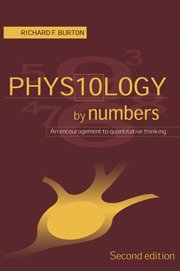Book contents
- Frontmatter
- Contents
- Preface to the second edition
- Preface to the first edition
- How to use this book
- 1 Introduction to physiological calculation: approximation and units
- 2 Quantifying the body: interrelationships amongst ‘representative’ or ‘textbook’ quantities
- 3 Energy and metabolism
- 4 The cardiovascular system
- 5 Respiration
- 6 Renal function
- 7 Body fluids
- 8 Acid–base balance
- 9 Nerve and muscle
- Appendix A Some useful quantities
- Appendix B Exponents and logarithms
- References
- Notes and Answers
- Index
Preface to the second edition
Published online by Cambridge University Press: 06 July 2010
- Frontmatter
- Contents
- Preface to the second edition
- Preface to the first edition
- How to use this book
- 1 Introduction to physiological calculation: approximation and units
- 2 Quantifying the body: interrelationships amongst ‘representative’ or ‘textbook’ quantities
- 3 Energy and metabolism
- 4 The cardiovascular system
- 5 Respiration
- 6 Renal function
- 7 Body fluids
- 8 Acid–base balance
- 9 Nerve and muscle
- Appendix A Some useful quantities
- Appendix B Exponents and logarithms
- References
- Notes and Answers
- Index
Summary
When I started to write the first edition of this book, I particularly had in mind readers somewhat like myself, not necessarily skilled in mathematics, but interested in a quantitative approach and appreciative of simple calculations that throw light on physiology. In the end I also wrote, as I explain more fully in my original Preface, for those many students who are ill at ease with applied arithmetic. I confess now that, until I had the subsequent experience of teaching a course in ‘quantitative physiology’, I was not fully aware of the huge problems so many present-day students have with this, for so many are reluctant to reveal them. Part of my response to this revelation was Biology by Numbers (Burton 1998), a book which develops various simple ideas in quantitative thinking while illustrating them with biological examples. In revising Physiology by Numbers, I have retained the systematic approach of the first edition, but have tried to make it more accessible to the number-shy student. This has entailed, amongst other things, considerable expansion of the first chapter and the writing of a new chapter to follow it. In particular, I have emphasized the value of including units at all stages of a calculation, both to aid reasoning and to avoid mistakes. I should like to think that the only prior mathematics required by the reader is simple arithmetic, plus enough algebra to understand and manipulate simple equations.
- Type
- Chapter
- Information
- Physiology by NumbersAn Encouragement to Quantitative Thinking, pp. ix - xPublisher: Cambridge University PressPrint publication year: 2000



